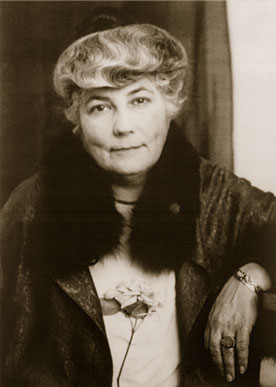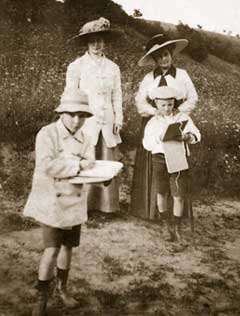In 1899, at her aunt’s, Princess Y. Putyatina, estate, Helena Shaposhnikova first met the young painter N. Roerich, who not only became her husband, but also her associate.,with whom she shared the same ideas. Unity of views, spiritual proximity and deep mutual reciprocal feelings made this union extraordinarily strong. “Together we overcame all kinds of encumbrances, Nicholas Roerich wrote about his marriage,” already in the later days of his life. “And obstacles turned into possibilities. I dedicated my books: “To Helena, my wife, friendess, companion, inspirer"[1, p.460]. “Friendess” – “druginya” – this is an ancient Russian word that very closely corresponded to Helena Roerich’s spirit and character. Many of N. Roerich’s paintings were the result of their common creative work, it was, as matter of fact, a “co-creation”, in which Helena Roerich was the inspiring element. As Nicholas Roerich wrote: “We created together, and not in vain it was said that the creations should bear two names – a woman’s and a man’s”[2, p.460].
In August of 1902, their son Yuri was born: a future scientist and orientalist, with a world-renowned name. In October 1904, Svetoslav was born: a future artist, thinker and public figure. H. Roerich was the heart, instructor and the most important founding element of the Roerich family. Nicholas Roerich, Yuri Roerich and Svetoslav Roerich highly appreciated the role of Helena Roerich as the bright genius of the family. In his memories, S. Roerich noted: “For us and all who came to close contact with her, this spiritual communication was kind of a live assertion of the highest verities of the ever-being truth. Her life was burning like a live light, establishing with its example existence of a beautiful world, comprehension of which will lead the humanity to new achievements, new discoveries”[3]. N. Roerich called Helena Roerich “She Who Leads” in his creations. At the same time, she was a person of amazing modesty. Having entered (once she had entered) the life of a famous artist, she always kept in the shadow. Most of her studies were published under pseudonyms. “<…> let me get down from the pedestal erected by your beautiful, loving heart <…> I like simplicity in everything, and any pomposity and solemnity are organically intolerable for me. I don’t like to teach, but just to pass knowledge”[4, p.246], she would write in one of the letters to her friend. Having found themselves cut off from their Motherland by the revolutionary events of 1917, the Roerichs left for England. There in London, in 1920, H. Roerich started writing down the first lines of the Living Ethics – a new philosophic system representing a modern integral concept of real Cosmos. The Living Ethics books were created by H. Roerich in close collaboration with a group of anonymous philosophers who are usually called Mahatmas (Great Souls) or Rishis (Teachers) in the spiritual tradition of India. In the autumn of 1920, together with her husband and children, H. Roerich left for New York, where Nicholas Roerich had planned a series of exhibitions in several USA cities. In America, under N. Roerich’s leadership and with H. Roerich’s direct participation, a small group of their associates launched wide reaching cultural and educational activities. The results of their activities were striking: the creation of the “Nicholas Roerich Museum”, of the “Master Institute of United Arts” and of the International artistic center “Corona Mundi”. These institutions, organized by Nicholas and Helena Roerich, turned into major cultural centers, the influence of which spread beyond the country’s borders and becoming International. Numerous societies, creative clubs and educational institutions offer their services all over the world under the aegis of these organizations, and, under the common dome of Culture, are united not only creative people, but also all those who strived for the implementation of humanistic ideals and improvement of life conditions. “It fills you with joy,” Helena Roerich wrote, “to see how, in the days of destruction, light souls come together in the name of Culture, trying to preserve the fire and give the happiness of creative construction and expansion of consciousness to those who are seeking for a way out of the formed intellectual dead end, which is also entailing material disaster”[5, p.386].
|
| |||||||||||||||
Copyright © 2008-2024 ST. PETERSBURG BRANCH OF THE INTERNATIONAL CENTER OF THE ROERICHS
Life and creative work of Nicholas Roerich | Exhibitions | Excursions | Scientific research | Protection of the Roerichs' name and heritage


